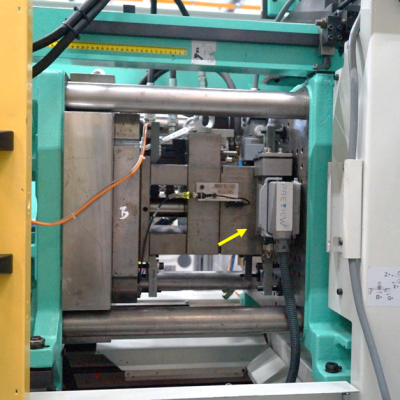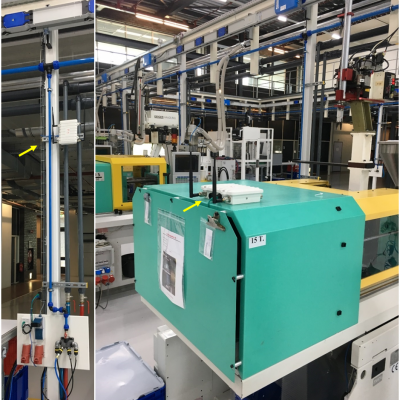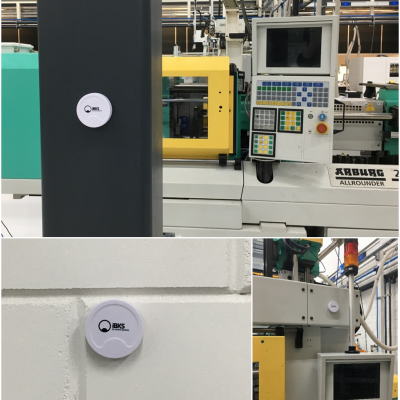After developing and small-scale testing the several subsystems for over two years, the partners in the European funded PREVIEW project (Horizon 2020) flew in to perform a full scale pilot test with the PREVIEW system at the Dutch partner Promolding.
Eurecat (Spain), Smithers Rapra (United Kingdom) and Humboldt Universität (Germany) took part in this test. Over a period of three days each team member contributed with its own specialisation in testing the system at Promolding’s new production facility.
During the first day (setup phase) three injection moulding machines were equipped with the PREVIEW data acquisition system (DAS, Figure 1). The DAS is a hardware module responsible for the adaption, amplification and digitalisation of the cavity and machine signals. These signals are supplied by cable to the PREVIEW wireless communication nodes (WCN, Figure 2) located at the machines. The nodes transmit the sensor data to the central wireless node which is connected to the PREVIEW server through Ethernet. This server node was installed in a convenient location on the production floor. All nodes together create a robust wireless network which uses a customised protocol. Also the Bluetooth beacons for the location-based content delivery were positioned throughout the production floor (Figure 3).
On the second day (test phase) the several subsystems were tested. This meant testing the data acquisition system by comparing the signals coming from the injection moulding machine and mould sensors, with the data received from the DAS. Several cables and connections were checked. Also the PREVIEW location based system (LBS) was tested. By checking the physical location on the floor with the virtual location on a floor plan displayed on a smart phone, this subsystem could be verified.
DAS Promolding
Figure 1: Injection moulding machine with mould with PREVIEW DAS

The PREVIEW server, consisting of the advanced predictive system (APS) and the content management system (CMS), and the wireless data transmission were validated by verifying the data reception, processing and storage in the database. The APS is a software algorithm to optimise the injection moulding process by reducing mould set up time and providing a quality control system.
Initially, this test went well, but once more data had been collected the server unexpectedly crashed. After a short period of recuperation from this puzzling situation, four specialists dove deep into the server software and found the stumbling block. The problem was then easily fixed. A true team effort.
In the meantime, to prepare for a life cycle assessment (LCA), some initial measurements of energy consumption of two injection moulding machines were performed, making use of a commercially available energy logger. This data is going to be compared to the data logged through the PREVIEW system to gain insight into the energy savings potentially created by making use of the PREVIEW system.
Figure 2: Wireless connection nodes, connected to Ethernet (left) and to DAS (right)

The third day was available for doing a full scale test, starting with a Design of Experiments on one of the machines involved. With the data obtained, the APS was trained. The moment of truth arrived: Will the smartphone app indicate a variation in the production process and recommend a process parameter modification when we deliberately alter a parameter on that specific machine? This would mean the whole chain from signal source all the way to a message on a smartphone would work. Success! Once the injection speed was lowered, the app effectively proposed to increase the speed. Happy faces after three days of hard work.
Figure 3: Bluetooth beacons placed in several locations

The third day was available for doing a full scale test, starting with a Design of Experiments on one of the machines involved. With the data obtained, the APS was trained. The moment of truth arrived: Will the smartphone app indicate a variation in the production process and recommend a process parameter modification when we deliberately alter a parameter on that specific machine? This would mean the whole chain from signal source all the way to a message on a smartphone would work. Success! Once the injection speed was lowered, the app effectively proposed to increase the speed. Happy faces after three days of hard work.


